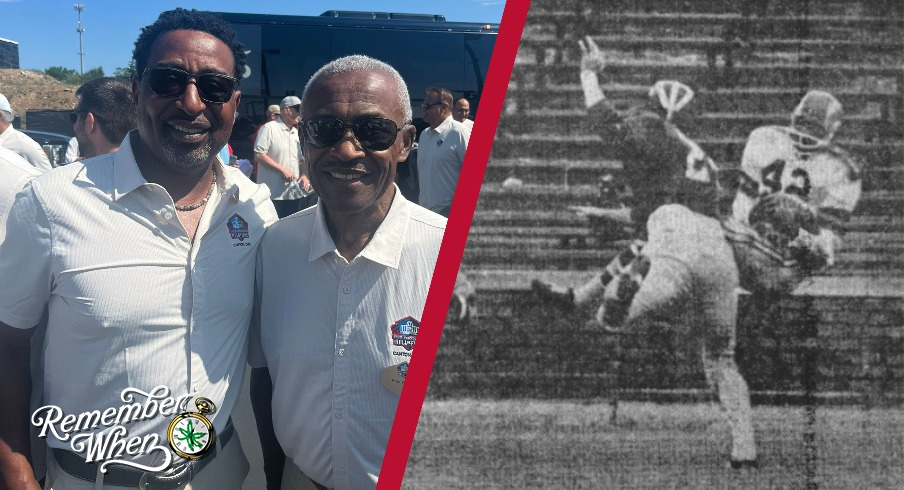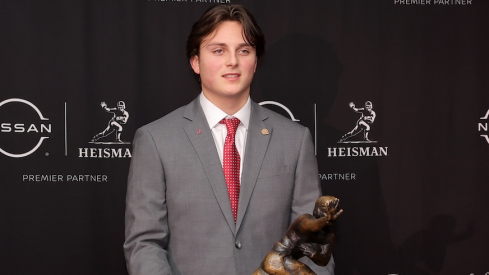In American football lore, Paul Warfield holds a legacy much more renown for his NFL Hall of Fame career spanning 14 seasons than his time at Ohio State. That's not to say the former All-American and 1961 National Champion failed to accomplish much of note during his time as a Buckeye. Rather, it serves as a reflection of the fact that Warfield's college position of "right end" functioned more closely to a modern running back than the Canton-caliber wide receiver he converted to full-time as a professional.
Yet, at last week's Hall of Fame ceremonies, one of Ohio State's indisputably greatest wideouts ever — Cris Carter — made the bold proclamation that Warfield deserves to have the conversation in that category "start" with the Warren, OH native.
Buckeyes fans, when the conversation starts about who were the greatest @OhioStateFB Wrs. Start that conversation with @ProFootballHOF Paul Warfield . pic.twitter.com/3Mpsu9iUmq
— Cris Carter (@criscarter80) August 1, 2025
The discourse around best Buckeye receivers ever has found itself a subject of heavy debate and speculation over the last year given the rapid ascension of Jeremiah Smith. At Big Ten media days only a handful of weeks ago, Smith offered up a Mount Rushmore of OSU WRs that included Carter, Marvin Harrison Jr., Jaxon Smith-Njigba and Ted Ginn Jr.
Do yall agree with Jeremiah Smiths @OhioStateFB WR Mount Rushmore?
— CBS Sports College Football (@CBSSportsCFB) July 23, 2025
@BMac_SportsTalk pic.twitter.com/3lzMD8MFeo
The absence of Warfield from many of these lists likely prompted Carter to remind Ohio State fans and the football world alike of what the 1983 NFL Hall of Famer contributed to the sport as a receiver. Warfield led the league in receiving touchdowns twice — once both as a Cleveland Brown and Miami Dolphin — on his way to making eight Pro Bowl rosters and earning All-Pro honors five times. He won three total NFL Championships, including two of the first eight Super Bowls, before eventually earning spots on both the 1970s All-Decade Team and NFL 100th Anniversary All-Time team.
At the time of his retirement after the 1977 season, Warfield ended his career as the second-most prolific wideout by receiving yards in NFL postseason history (1,121), merely 46 yards behind Fred Biletnikoff. In the nearly 50 years since the end of his professional career, only 10 other players have surpassed that total.
Yet, one could easily earn forgiveness for leaving the great Warfield out of the discussion for best Buckeye receivers ever based on what they achieved at Ohio State. Warfield barely recorded half as many receiving yards during his Buckeye career (525) as he did on the ground (1,047). His most notable statistical achievement was likely leading the Big Ten in yards-per-carry during the 1962 season (6.4), though it also seems worth noting his rushing totals decreased each season of his career while his receiving yards progressively climbed.
Woody Hayes must have eventually recognized what Browns head coach Blanton Collier similarly did in Warfield's potential as a pass-catcher given his versatile athleticism. Warfield earned two-time letterman honors in track and field as a Buckeye while competing in broad jump, hurdle and sprint events. He had also won the Ohio High School Athletic Association Class AA broad jump championship prior to enrolling at OSU and set a Class AA record in the 180-yard hurdle event on his way to winning that title as well.
However, despite Warfield helping Ohio State win a third national title under Hayes in 1961, the rest of the offensive talent around him failed to measure up during his subsequent upperclassmen years in Columbus. The Buckeyes went 6-3 the following season when Warfield led the conference in yards-per-carry before achieving a 5-3-1 record a year later. The team failed to break into the double-digits in all three of its losses.
Such shortcomings in scoring help explain why the two best receiving games of Warfield's Ohio State career occurred during his final two games in scarlet and gray. The only 100-yard receiving performance Warfield had in college happened in the penultimate game of the 1963 season, which the Buckeyes ultimately lost at home to the Northwestern Wildcats by a 17-8 final score. Warfield hauled in seven receptions for 106 yards and his 31-yard touchdown catch proved to be the only visit to the end zone Ohio State made all day.
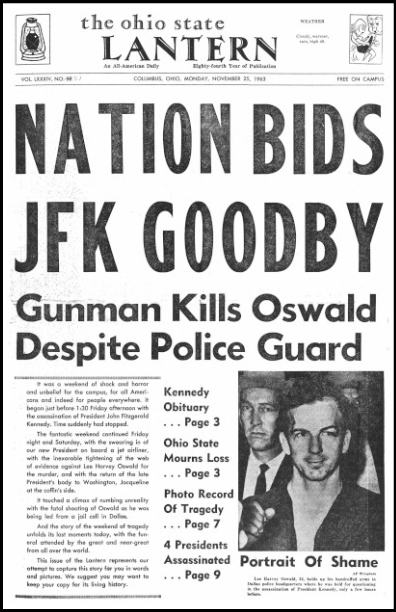
The Buckeyes were set to travel to Ann Arbor for their season finale the following week. But just six days after the loss to Northwestern, John F. Kennedy became the fourth sitting President of the United States to die of assassination.
The outpouring of grief from a nation in mourning illustrates itself clearly in the November 25th, 1963 edition of The Lantern. The story dominated all but one of the pages in the first edition of the student newspaper that published three days following the tragedy, and only a day removed from the demise of JFK's accused assassin Lee Harvey Oswald.
On page nine, an article detailed the decision made to postpone The Game by a week out of respect for the death of a U.S. President. A day before the 50th anniversary of the assassination, former OSU cornerback Arnie Chonko told Dan Hope in a 2013 interview with The Lantern that the team had actually already begun dressing for The Game at The Big House when the announcement of its cancellation came through.
Although all tickets purchased for the November 23rd date would remain valid for the rebooked meeting on November 30th, it remained unclear whether or not those that could no longer attend would be eligible for refunds. Ohio State athletic director Richard Larkins appropriately contextualized the chaos of the moment in saying, "there is no precedent for a decision on this."
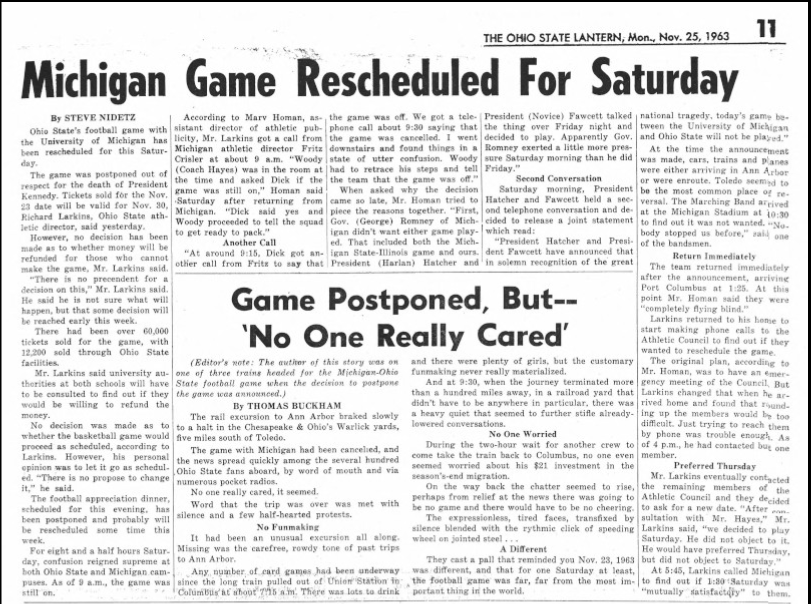
Thanksgiving that year took place on November 28th. This meant that several students and staff across both universities would have already returned home to spend the holiday with their families. The moment of grief the nation found itself in indubitably only intensified the average person's desire to gather their loved ones close and retreat to safety.
Such sentiment ultimately reflected itself in the attendance at The Big House on the snowy and bitterly cold final day of November. The 1963 installment of The Game to this day remains the lowest-attended meeting at Michigan Stadium in the rivalry since the venue first opened in 1927. Only 36,424 people attended the contest in Ann Arbor that day after The Big House had previously hosted over 100,000 people for the Paul Bunyan Trophy game against Michigan State a month prior.
The Wolverines appeared to shake themselves out of the emotional shock of the moment faster than the Buckeyes did. Ohio State fumbled away possession of the ball on just its second offensive snap, which set up Michigan scoring the only points of the first quarter on a field goal. TTUN then made either side's first trip to paydirt that day on a 12-play, 53-yard drive in the second quarter to put the Wolverines ahead by a 10-0 score.
The circumstances appeared even grimmer for the Buckeyes than they had prior to the start of The Game as halftime drew near. Former tight end and eventual mayor of Columbus Greg Lashutka admitted in the 2013 interview with Hope that playing football in wake of the JFK assassination, "was hard enough a week later, let alone the day after." Linebacker Ike Kelly asserted that the demeanor of team at the time was effectively, "'this game isn't really important."
In times of overwhelming distress, heroes tend to rise. Paul Warfield did just that.
Michigan found itself forced to punt the ball out of its own endzone with less than a minute remaining in the second quarter. The punt traveled to merely the Wolverines' 45-yard line before Warfield successfully downed the ball.
On the first snap of the series, Warfield successfully hauled in a 10-yard pass from quarterback Donald Unverferth on an out-route, getting both feet in-bounds before successfully sliding out at the 35-yard line to stop the clock.
Warfield then lined up on the opposite side of the field for the next play. Unverferth took the snap from under center and initiated a play-action fake to his fullback before rolling out to the left and resetting his feet.
What happened next may be the most underappreciated touchdown catch in the history of Ohio State football.
At 17:34 in the above YouTube video of The Game, Warfield took off from the line of scrimmage out of a three-point stance and successfully evaded the Michigan defensive back in front of him playing shallow coverage. Before Warfield had even crossed the red zone on his go route, Unverferth had already made up his mind to chuck the ball deep despite the presence of two Wolverine safeties.
Beginning his leap from the goal line, Warfield put his broad jump credentials into action and flew through the air while turning back to the throw. He caught the first score of the day for the Buckeyes over a pair of defenders with just 41 seconds remaining in the first half.
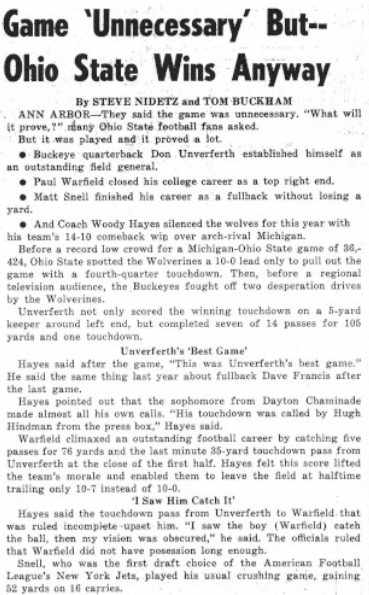
The moment of brilliance from Warfield clearly inspired a comeback attitude from Ohio State's entire team heading into the locker room. The Wolverines would not score again for the remainder of The Game, and the Buckeyes finally captured the lead midway through the final quarter after a 15-play, 76-yard drive that concluded in a five-yard touchdown rush for Unverferth. Ohio State won 1963's edition of The Game by a final score of 14-10 and successfully avoided ending the season with merely a .500 record.
Warfield finished the game with five receptions for 76 yards and the phenomenal touchdown catch that proved to foreshadow his future as one of the greatest wide receivers of his era in professional football. Both totals were his second-most in a single contest across his Ohio State career only to his efforts against Northwestern in the previous game.
Two days later, the Cleveland Browns selected Warfield with the 11th overall pick in the 1964 NFL Draft. Warfield became one of six future Hall of Famers selected among the first 18 picks in that class. His conversion to wide receiver helped the Browns win the NFL Championship during his rookie year in 1964, and many fans of the franchise — including Ramzy Nasrallah — still consider him one of the best receivers in team history.
